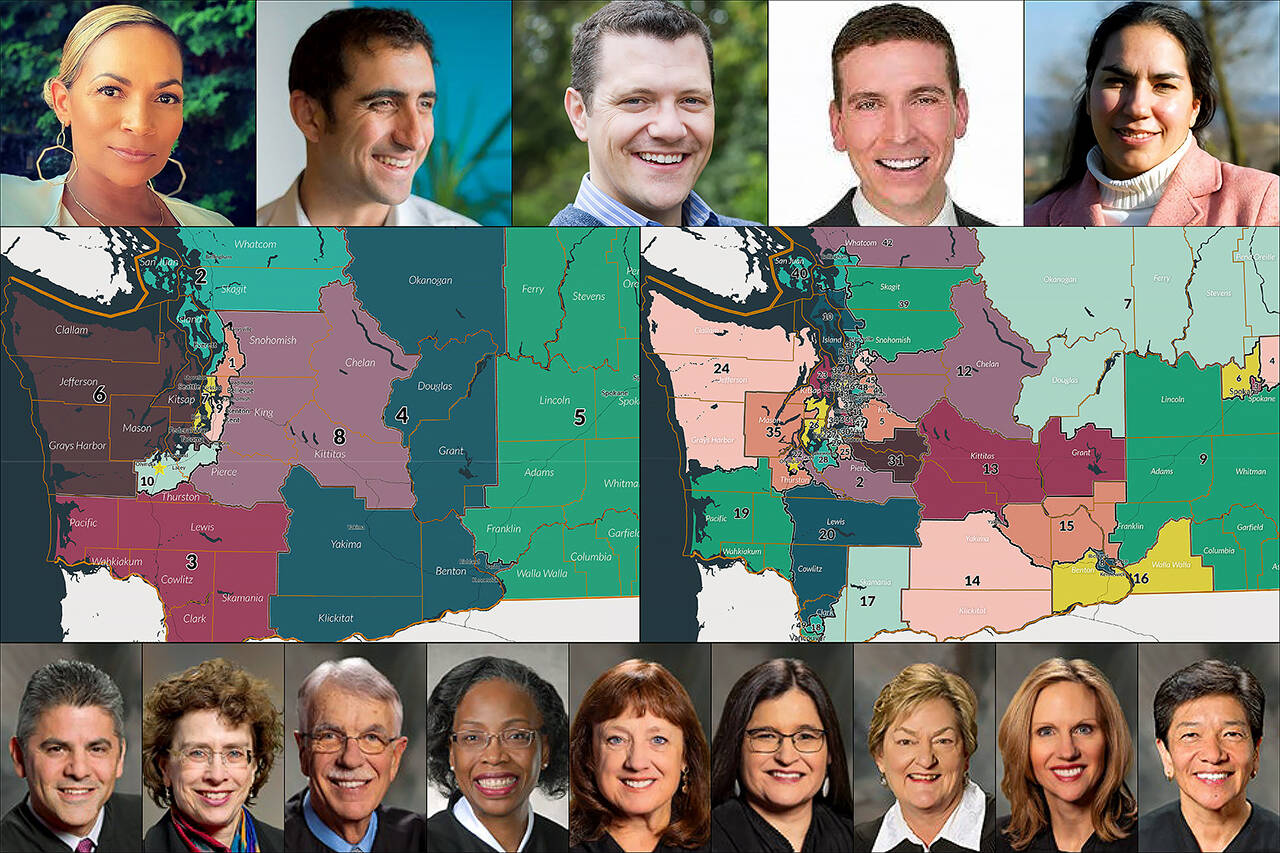OLYMPIA — A legal battle on the validity of the state’s new political maps returns to Washington’s Supreme Court this week.
Separate lawsuits filed by the Washington Coalition for Open Government and by Arthur West of Olympia contend legislative and congressional maps produced by the state’s redistricting commission must be invalidated.
They argue commissioners violated open meeting laws, negotiating secretly for hours Nov. 15, before hurriedly voting on new boundaries that were not publicly displayed or debated. Those votes, some of which occurred after the deadline, must be voided, contend the lawsuits which name the Redistricting Commission, commissioners and the state as defendants.
On Thursday, the state Supreme Court will meet to consider consolidating and accepting the cases.
All parties in this fight agree the nine justices should settle the question and quickly.
They’ve proposed an expedited schedule for filing briefs and conducting discovery — including deposing of individual commissioners — culminating with a decision from the court by Jan. 31.
A month ago the court decided against redrawing the boundaries itself as prescribed in the state Constitution when a redistricting commission fails to act on time. Justices, relying in part on an affidavit from the commission’s chair, concluded the panel did its job, though it missed its deadline by minutes, and should send the new political maps it drew to the Legislature.
In the aftermath of what was a chaotic evening, commissioners acknowledged not finishing on time nor seeing completed maps until the evening of Nov. 16. Public records indicate commissioners had not agreed on all the specific boundaries at the time of their votes. At least one commissioner did not see the final iterations before those were sent to the court.
“It is evident Chair (Sarah) Augustine omitted substantive facts and was either not well informed regarding the absence of any consensus or chose to represent that there was consensus on districts when clearly there was not,” Joan Mell, attorney for the open government coalition wrote in a court filing. “This Court has blessed Commission action that was blatantly nontransparent and incomplete by the requisite constitutional deadline that puts redistricting defects squarely before this Court.”
In an interview, Mell said justices got some “bad facts.” She said if the court takes the cases it must not limit the scope of fact-finding.
“The coalition wants the Supreme Court to understand as loathe as it is to decide redistricting, overlooking the lack of transparency simply encourages disregard of it in the future,” she said. “Also, I am confident that the only reason the discussions were done in private was to lobby politically when that too is prohibited.”
Zach Pekelis Jones, a private attorney hired by the redistricting commission, declined to comment on the litigation. The Office of the Attorney General provided counsel to the commission during the yearlong map-making process.
As for the state’s case, Brionna Aho, spokeswoman for Attorney General Bob Ferguson, declined to comment.
“In terms of the substance, the parties’ pleadings will speak for themselves,” she said.
A thrust of the lawsuits is that the court must not focus on the end product — the drawing of new maps for Washington’s 10 congressional and 49 legislative districts — but the process the commission followed to get where it did.
It was messy.
The four voting members of the commission gathered at 7 p.m. Nov. 15, facing a deadline of 11:59 p.m. to approve final maps and resolutions, and send them to administrators of the state House and Senate.
While the meeting was conducted virtually, and televised on TVW, the quartet — Democrats April Sims and Brady Walkinshaw Pinero, and Republicans Joe Fain and Paul Graves — were themselves at a hotel.
In the course of the five-hour meeting, commissioners negotiated privately off-camera, in groups of two. There was no discussion or deliberation in public before they cast a series of votes to seemingly carry out their duties.
“Great job, everybody. Congratulations,” Augustine, the panel’s non-voting chair, said that evening before ending the meeting.
Augustine had said earlier in the evening the actual maps still needed to be drawn and that they should be done by “sunrise.” None were posted until late the next day.
By then it was clear they had not completed their work, shifting the responsibility to the Supreme Court.
On Dec. 3, the court signed off on the commission’s work. The two lawsuits aim to change the minds of justices.
If the court finds the redistricting plans are valid, they will be sent to the Legislature, which will have until Feb. 10 to amend them. Any revisions require support of two-thirds of each chamber.
Should justices rule that the plans are invalid, they will have until April 30 to produce final plans. Those could be the very ones drawn up by the commission. The Legislature would not have any role.
Once final maps are adopted, the boundaries will be in force for elections from 2022 through 2031.
Jerry Cornfield: jcornfield@heraldnet.com; 360-352-8623; Twitter: @dospueblos.
Talk to us
> Give us your news tips.
> Send us a letter to the editor.
> More Herald contact information.

























